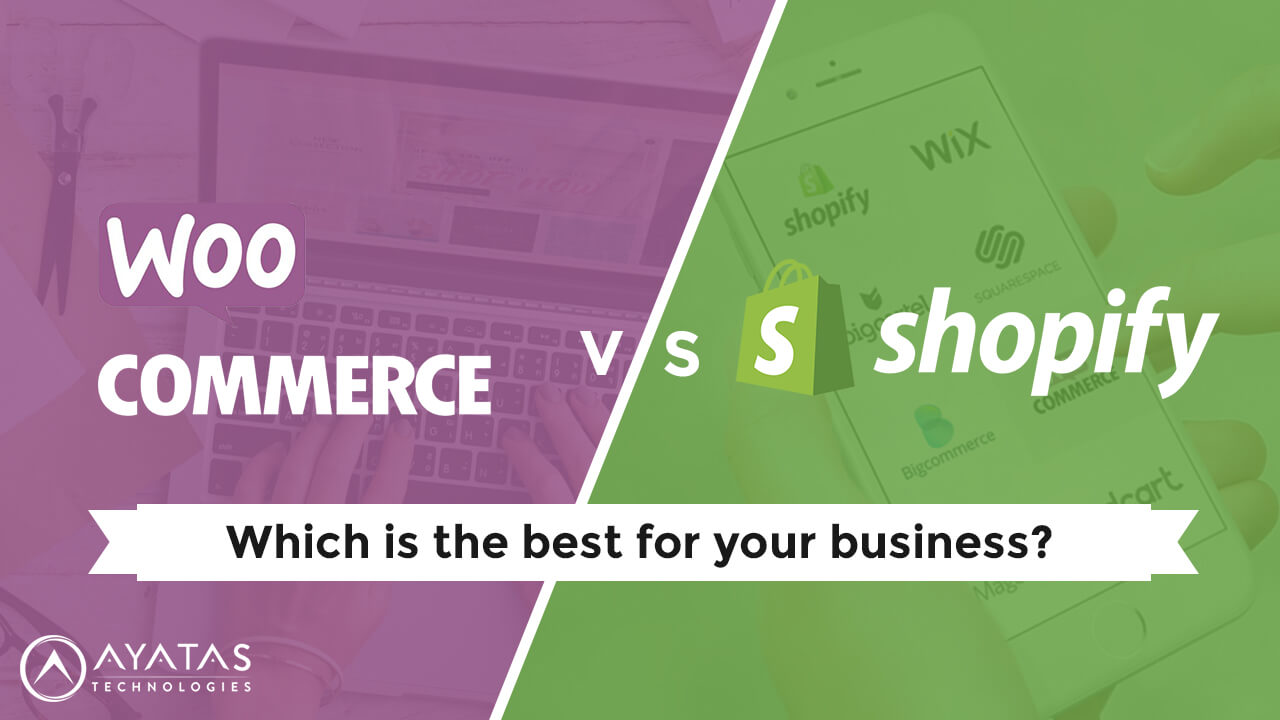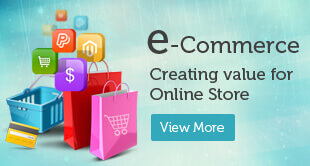
WooCommerce vs Shopify – Which is the Best Platform for Your Business?
As a business owner, you must choose the right platform to showcase your online store to the digital world. Shopify and WooCommerce are both top class eCommerce platforms, each having their pros and cons. While WooCommerce powers 22% of the online stores, Shopify powers 17% of total online stores. Read on to know the main differences between WooCommerce Vs Shopify.
What is Shopify?
Shopify is an eCommerce platform that helps in developing an online store, accepting payments, and manage inventory all from a single platform. You also need not worry about the technical stuff of managing your website or online store.
What is WooCommerce?
WooCommerce is an open-source WordPress plugin that helps you to leverage content management system and run it on your online store. As the plugin is open source, you have the option to customize every aspect of your store according to your requirements.
When you are trying to choose between these both eCommerce platforms, you need to know which one is better based on your needs. In this article, we will focus on the elements that can be useful to decide which platform is best suitable for your business.
1. Hosting Options
Reliable hosting is a must for all websites and specifically crucial for eCommerce websites. Online stores can experience heavy traffic at times of special offers seasons. Know the hosting options in WooCommerce Vs Shopify.
Shopify is a proprietary platform, and your site is hosted on servers of Shopify. You have the benefits of infrastructure and unlimited storage. You can also point to a domain name that you have already purchased.
In WooCommerce, you have to choose the provider to host your online store, and you can have the choice of server applications like size, storage, bandwidth, and processor. Most of the experts use the option of an auto-scalable hosting provider as your store is operational, even in heavy traffic times.
2. Customization of Themes
User Interface is crucial for all eCommerce websites since it creates the first and last impression on your online store.
WooCommerce does not have its Theme store, and you have to take them from online theme stores like Themeforest and Envato. Always make sure to choose a theme that gives your users a smooth experience regardless of the device they are using.
Shopify has more than 70 paid and free themes with exceptional quality. These themes can be customized without touching a line in the code. If you need further customizations, you can try Shopify’s programming language.
3. Ease of Use
WooCommerce is not a hosted platform, and you have to set-up all the hosting by yourself. You have to connect your SSL certificate and domain name, install WordPress, and tweak the setting, install WooCommerce, and every other plugin that you need, install your theme, and all of that. If you are a beginner, you require to spend more time for installation purposes.
On the other hand, working with Shopify is much more comfortable, and setting up your store takes just two to three hours. Shopify comes with a drag and drop interface to manage your products, sales, and inventory.
4. Add ons and Extensions
WooCommerce is an open-source platform and gives you access to more than 55000 free and paid plugins used to add payment gateways and lead generation. Most of the third-party tools and add-ons are integrated with WooCommerce store.
Shopify has powerful API and an App Store where you can buy third-party add-ons. They are hundreds of apps in the store covering every feature you want to add to your store. For lead generation, you can use OptinMonster, to help you grow your e-mail list and reduce cart abandonment. There are both free and paid apps.
5. Plugins
With WooCommerce, you have the option to sell both digital and physical products. More plugins are making the platform almost endlessly customizable. Plugins are mostly free to use and help you to accomplish pretty much anything for your store. WooCommerce has its extension store, and the premium plugins let you do more than expected.
In Shopify, you receive automatic updates based on the survey you have filled at the start of the application. Some of the apps are free to use, and for some, you have to pay. However, the free plan only allows for ten products to be reviewed and five reviews. If you have few services or products, this free app isn’t going to be of much help.
6. Payment Gateways
Payment options are crucial for any online store.
WooCommerce offers many payment gateways like PayPal and Stripe, which are free while other solutions like Authorize.Net, Amazon Payments, or Braintree are paid. Stripe and Paypal are an excellent choice to launch an ecommerce store.
Shopify offers payment options such as PayPal, Amazon Payments, and others. Note that Shopify Payments is only available in certain countries, including the United States, Canada, the United Kingdom, and Australia.
7. Shipping Methods
Both WooCommerce and Shopify allow you to set the shipping costs according to the parameters of products like size and weight. The price can also vary based on the location you are shipping. You can set up a real-time calculation of shipping costs with different delivery options like FedEx and UPS.
8. SEO Optimization
SEO is the key to attract more customers to your website and increase your revenue. When it comes to WooCommerce and Shopify, both are the best platforms and offer the best SEO options to ensure that your products are displayed on the top in Google search results.
WooCommerce gives you control over SEO and every other aspect of your store. You have the option to add detailed meta descriptions and titles to your pages to tell Google what they’re about.
Shopify also offers excellent SEO functionality and has a range of plugins in its App Store. The SEO Booster app scans your store and provides you to fix the problems. Shopify sites are faster, which is an added advantage in SEO and also adds SSL certificates. It is easy to add the necessary SEO meta information to your store. You can add descriptions and titles for your images, products, and pages.
9. Customer Support
In WooCommerce, there is no particular customer support available, but a huge community of users can always help you through various forums available.
Shopify has dedicated customer support. Once you have paid the subscription, you can benefit from the 24/7 assistance from an e-mail, chat, and phone. The only constraint is that you have to talk in English.
10. Analytics
As WooCommerce is part of WordPress, you have the advantage of having two robust analytics tools to track your performance. The tools are the Reports Admin menu and Google Analytics. The reports admin tool gets all the information related to Sales trends, percentage of customers, inventory data, and tax details. In Google Analytics, you get all the data related to audience, acquisition, behavioural, and conversion insights.
In Shopify, you can use Analytics Dashboard to get all the data. You can do a lot of the data filtering and display manipulation from right here in the dashboard. That’s a helpful feature to have if you want to save custom configurations as reports. There is also an option to export data into CSV for future assessments. There are also options similar to Google Analytics. To make most of these applications, you can upgrade to paid versions and gain more advantages.
11. Security
High-level security should be a part of every eCommerce website as you are holding personal and financial information from your clients or buyers.
WooCommerce is self-hosted, so it does not come with built-in security. So it is up to you to install security features on your website or take the help of your hosting provider.
Shopify takes care of your website’s security, as it is a hosted eCommerce platform. Shopify handles all the security breaches, and your site is safe from hackers.
12. Backups
WooCommerce does not have a backup system, but there are plenty of plugins that are free and paid. You can use these plugins to backup all your data to any location you want. Restoring a website from backup is also easy, and you do not need a separate plugin. You also have the choice of automating or managing on your own.
Storing data in Shopify is somewhat tricky as Shopify itself runs all the code. Using the backup feature, you can get details of customers, discounts, gift card codes, orders, and products. If you want to backup all the data, then you need to use apps.
13. Pricing
WooCommerce is free and pocket friendly. In WooCommerce, you will be paying only for what you need. Hosting and security features might be the extra costs that might be incurred for your website. If you are running a simple store, then anything around $3 is enough for hosting. Based on the traffic for your website, you have the choice of choosing the hosting vendor.
Shopify offers several plans. Plans are vary based on the type of business you are running. If you want full solutions for your website, then you need to have a $299 per month plan, with which you get features like fast loading website, free SSL certificate, abandoned cart recovery, and inventory. In addition to these, you are also charged transaction fees.
So Which is the Best Platform for Your Business?
You need to choose between WooCommerce and Shopify based on the website or online store that you are running or about to build. If you are looking to double your affiliate marketing or drive traffic through content for search engines, then you need to choose WooCommerce. On the other hand, if you are new to eCommerce and do not want to bother about technical details, then you need to go for Shopify.
Conclusion
Maybe it is Woocommerce, Shopify, or other major eCommerce platforms, our developers at Ayatas Technologies has got the expertise and experience in building robust online stores. We delivered eCommerce solutions to notable B2B and B2C brands for different verticals. Contact or Call us at +1 916-936-8099 to discuss more details on your next project and to schedule a FREE demo.



